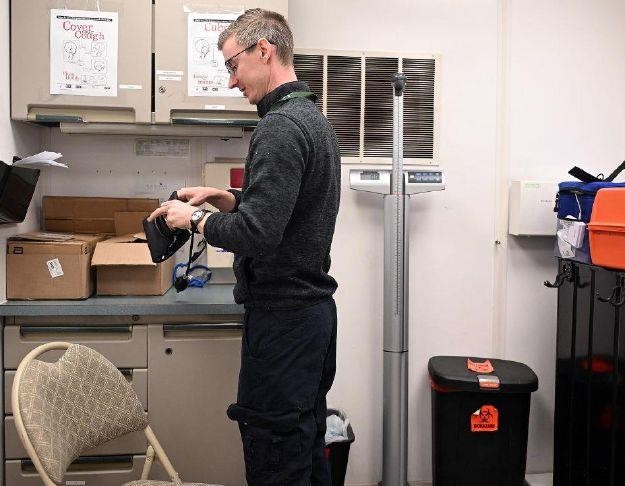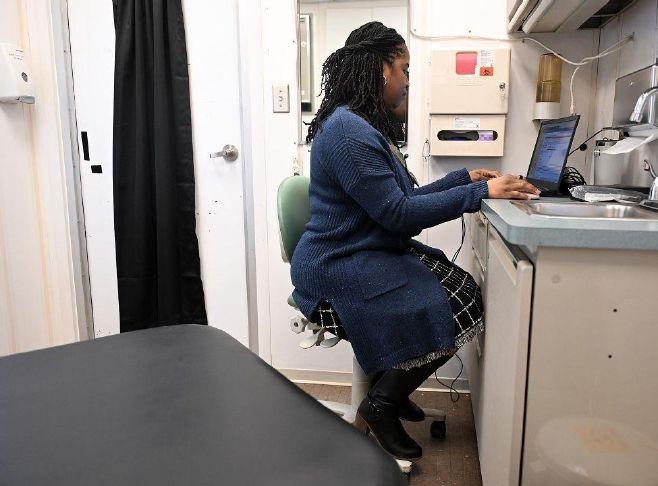
“A MOBILE SOLUTION TO RURAL HEALTH BARRIERS IN CONNECTICUT’S NORTHEAST” Article in The Day Newspaper by Alison Cross



The Generations Family Health Center’s mobile clinic is parked outside the Hale YMCA Youth & Family Center in Putnam Tuesday, April 8, 2025. (Sarah Gordon/The Day)
Alison Cross
Day Staff Writer- Author
Apr 20, 2025 3:00 PM
Putnam — On a rainy Tuesday, medical staff from Generations Family Health Center prepped for a day of appointments outside the Hale YMCA.
From inside the exam room, you never would have known the office was on wheels, save for the constant rumble of the truck’s engine that kept the operation running.
In a region with fewer health care providers per person than anywhere else in the state, Generations is working to boost access by making dental and medical care mobile.
For each primary care provider or dentist in Windham County, there are 2,050 residents, a 2022 report | Opens PDF by DataHaven found. The state average is 1,430 for every provider.
Within the northeast, Plainfield and Killingly are home to the lowest rates of health care utilization in the region. In 2020, up to 37% of adults in these areas had not been to a dentist within the past year and up to 27% did not have an annual checkup in 2021, according to a DataHaven report | Opens PDF on the 17 towns that make up the Northeastern Connecticut Council of Governments.
From rural parts of Putnam, Plainfield and Killingly to more urban areas in Norwich and New London, the Generations Mobile Health Unit travels each week to apartment complexes, community centers, YMCAs, schools, farms and other local hubs to provide dental and medical care in places where traditional health facilities are out of reach, either physically or financially.
Registered nurse Greg Hook described the Mobile Health Unit as a “traditional health center catering towards those who don’t have that traditional access.”
“We really try to bring health care closer to people,” Megan Thorton, Generation’s community health and infectious disease program manager, said. “This really is a public health and a community health effort.”
Breaking barriers
Kaleena Crooks, an advanced practice registered nurse with the mobile unit, said the program is about “accessing people where they are.” While appointments are recommended, walk-ins are always welcome.
“Not a lot of people can get to the office, and sometimes it can be a lot just to get that appointment in the office,” Crooks said. “We’re here and we’re open to anybody. … You see the bus, you come in, you get seen and we’ll help you as much as we can.”
On a Wednesday morning, Jeniffer Quiles stepped out of her home at Windham Heights Apartments and walked to the Mobile Health Unit stationed in the complex’s parking lot for a dental check-up.
While Quiles has a dentist, she said her time off as a paraprofessional is limited. Quiles said her few days off are usually spent bringing herself or her three kids to medical visits.
That day, Quiles had already taken paid time off for a doctor’s appointment, so when she learned that the mobile unit would be offering dental care, she signed up for her first visit. It helped that the unit was right outside her apartment building — Quiles does not drive, and that day her husband was not available to drive her.
“It was super convenient,” Quiles said in Spanish as the mobile unit’s community health worker, Glory Cruz, translated. “It was really good. (The hygienist) had good hands and she was really nice.”
As she said goodbye to the mobile unit’s staff, Quiles explained that she needed to look for the bus schedule — if it did not line up with her 11 a.m. appointment, Quiles said she would need to walk more than an hour to get to the doctor’s office on her own.
“Transportation is a huge barrier in our system. Uber and Lyft are kind of non-existent up here,” Thornton said. “If you live in Danielson and your doctor’s up in Putnam, you’re not walking.”
Thornton said other prohibitive factors include a lack of paid time off and high costs that make health care out of reach for some patients.
“When you are worried about paying just your basic needs, your health care just simply comes last,” Thornton said. “(If) you have to pay your electricity, and you got to get groceries for your kids, (and) you got to pay your rent, you don’t think ‘Well, I need to go to the doctor and check out my hypertension.’”
Not just medical care
Thornton explained that at the mobile unit, staff “try to be a one-stop shop,” with onsite enrollment for insurance, SNAP benefits, energy assistance, housing programs and other community resources.
“All the things that really make coming here and getting your health care a lot easier,” Thornton said.
Generations, a private, not-for-profit, regional Federally Qualified Health Center, and its mobile unit also operate on a sliding fee scale with payment programs for patients who do not have insurance.
Crooks explained that getting patients adequate care can require a bit of creativity, especially when costs are not covered by insurance.
“For people that come in, they don’t have insurance, but they have all these chronic conditions. I can’t just simply say ‘Oh you’re going to see an endocrinologist or you’re going to see a cardiologist, or do this imaging’ because they don’t have the money to do it,” Crooks said. “It’s (about) finding creative ways … to provide this quality care with what we have.”
Crooks said that sometimes what patients need is not expressly medical.
“Sometimes it’s just ‘I need shoes over the winter, and I don’t have shoes,’” Crooks said. “(We say) ‘OK, where can we get that? Can we find some funds or can we get them shoes?’ So sometimes it’s social needs as well.”
Educating patients
Brandie Frechette, a registered dental hygienist, said most patients at the mobile unit “aren’t aware how unhealthy their mouths are until they come in.”
In addition to Generations, Frechette said also works as a hygienist at a private practice. In traditional dentist offices where patients come in twice a year for cleanings, Frechette said practitioners can keep up with preventative treatments, catch cavities before fillings are required and address concerns as they arise.
The typical mobile patient does not have that same level of preventative care.
“In private practice … we have a pulse on their health. We’re able to compare back to six months ago, continue to educate them, continue to clean their teeth, (and) assess their periodontal health,” Frechette said. “Here (at the mobile unit), it’s kind of the opposite. We’re trying to chase that disease, chase that cavity, rather than being able to prevent and stop it where it’s at.”
“There’s definitely a higher need here because they’re not followed, they don’t have a dentist of record and they don’t have preventative care,” Frechette added. “We’re trying to bridge that gap to get them back into a facility where they can see the dentist regularly.”
Aside from cavities, Frechette said one of the most common conditions among mobile unit patients is gum disease.
According to the Centers for Disease Control and Prevention, roughly 60% of low-income adults between the ages of 20 and 64 have periodontitis, a type of gum disease that can lead to bone loss, bacterial infections and has been linked to respiratory disease, rheumatoid arthritis, coronary artery disease and other conditions. In comparison, periodontitis impacts just 30% of adults from higher income thresholds.
Frechette said that part of the challenge is a lack of education.
“They’re not aware, if they have bleeding gums, what that could do systemically to their overall health,” Frechette said.
Preventing ER visits
Hook said one of the unit’s goals is treating patients before they end up in the emergency room.
A 12-year study published by the National Library of Medicine found that between 2005 and 2016, the rate of ER visits in rural hospitals rose by 75%, outpacing hospitals in urban settings whose ER visit rates rose by 6% over the same period. The researchers noted that the rise in rural ER use was particularly apparent among Medicare beneficiaries and uninsured patients. By the final year of the study, rural hospitals in the U.S. had 65 visits per 100 persons in their ERs, urban hospitals had 43.
Hook explained that some patients with chronic respiratory problems would visit the ER up to four times a week for treatment. Now, Hook said the mobile unit can manage their acute illness before their condition exacerbates.
Hook said ER visits are also common for patients with unmanaged diabetes. When blood sugar levels skyrocket or fall dangerously low, Hook said the ER can offer a “quick fix” but it does not address the root cause of the problem.
Hook said mobile unit visits can offer more time to provide individualized care.
“We can actually focus on that chronic illness. I have the time to go through individual diets with patients, (and say) ‘Hey maybe we shouldn’t be eating this. Maybe we should switch to this.’ And then really focus on (asking) ‘What are your personal barriers? Why are you eating like this? Why are you not able to administer your medications properly?’” Hook said. “It’s more of a refined focus.”
For some patients, Hook said it’s just a matter of making sure patients have the prescriptions they need to treat hypertension, high cholesterol, diabetes and other conditions.
He said the impact of the mobile unit becomes apparent once the patients return.
“They come back in a month, two months, three months, completely managed, or at least in a much better spot,” Hook said. “That’s always a good thing when you see this astronomically high number start reducing every single time you see the patients.”
a.cross@theday.com